You can get some Peru fruit at home but you need to travel for the most unusual and tasty fruits.
It took a long time for North America to realize that Peruvian food is one of the best in the world. But it’s finally on trend.
And yet I’m always shocked that Peru fruit doesn’t get the same attention.
We import so many fantastic things from other countries and somehow forget about this powerhouse.
Peruvian fruits are incredibly diverse. Not only is Peru home to many of the miracle fruits of the Amazon, which many claim will cure everything.
But also there’s also fantastic fruit along the coast, in the Andean valley and mountains.
Food in Peru was definitely a highlight for me. It drew me in like no other country in South America.
But I also cannot forget about all the Peruvian fruit juices and market stands selling things I had never seen or heard before.
As I write this I’m making a mental note to go back to Peru.
21 Unique Peru Fruit to Devour
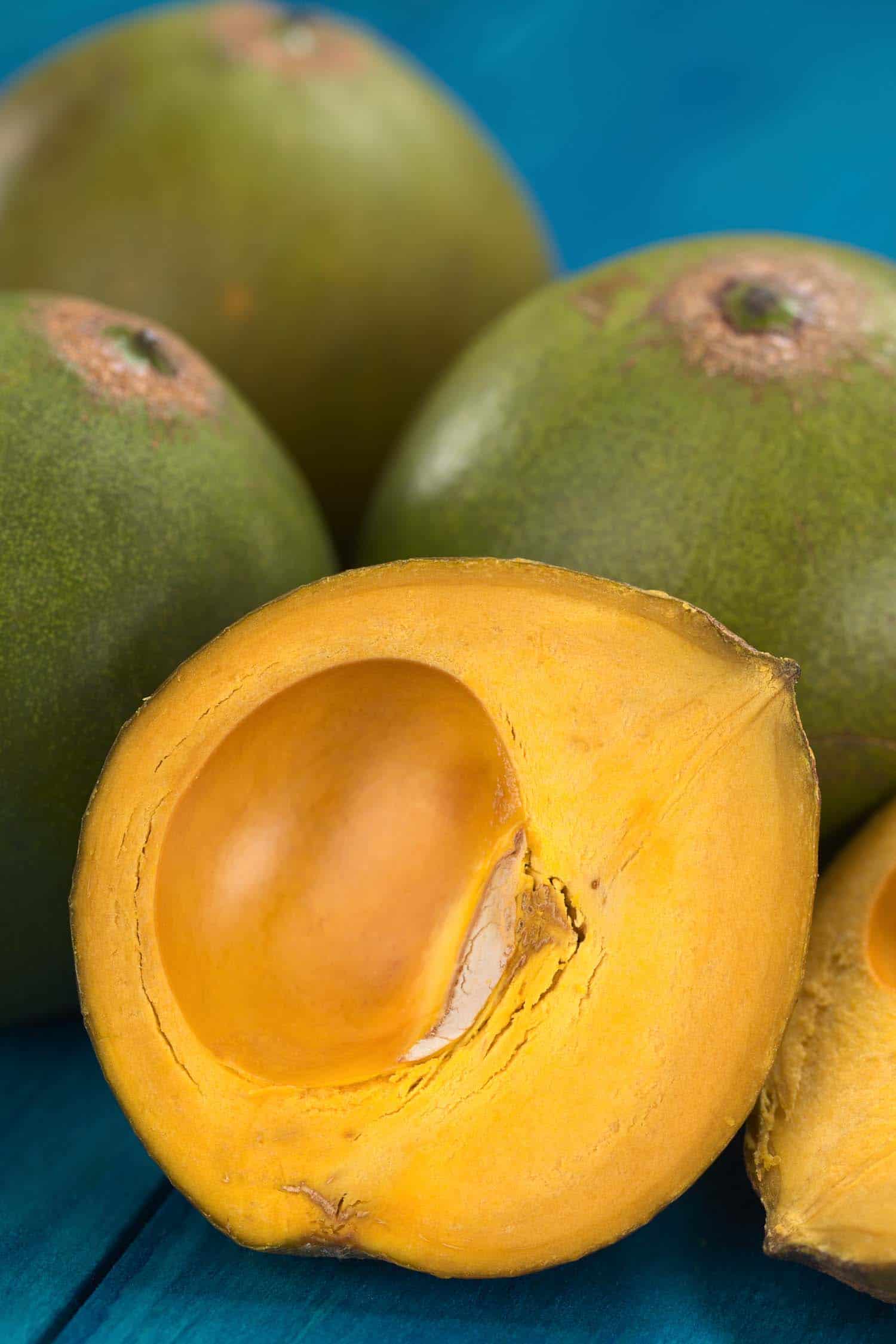
Lúcuma
I’m starting with this Peru fruit because you don’t find lúcuma anywhere else…well actually that is not entirely true.
You can also find lúcuma in Chile, Costa Rica and as far as South East Asia where it’s a popular fruit in Laos.
But it is so tied to Peruvian food culture that it’s known as the national fruit of Peru.
Lúcuma has been around for centuries. We know this because you can find it on ceramics from the indigenous people. It is called the last gold of the Incas for its high nutritional value.
Exotic Fruits
Unfortunately it has a terrible English translation as we call it eggfruit. But not because it tastes like eggs – that would be a disgusting fruit.
Instead because the bright yellow flesh reminds people of eggs. Instead lúcuma has a sweet flavour, somewhat similar to a sweet potato or even a banana chocolate combination.
Who doesn’t love chocobananos?
If you’re only going to eat one Peruvian fruit this is the one to eat.
And it’s not that difficult to find because it is probably the most popular ice cream in Peru. Peruvians love lúcuma ice cream more than vanilla, chocolate or even delicious maracuya.
People don’t really eat lúcuma raw but if you’re not up for ice cream head to the market and get a lúcuma smoothie.
Lúcuma Season in Peru
January to March, August to November
Cherimoya
Although Peru fruit is exported all over the world, you have to go to Peru to find their cherimoya. Or head to the Caribbean as it’s a common Cuban fruit.
Those who eat it adore it. Writer Mark Twain said it was “the most delicious fruit known to man.”
I think it’s because it’s a creamy fruit. So you get the best of both worlds – sweet and smooth.
It’s not surprising that in English it’s often called the custard apple.
The outside isn’t anything to look at – scaley and rough. But inside the flavour is like a banana pineapple mix. It’s possible to eat it raw, but also makes an excellent juice or smoothie without adding any other fruit.
Cherimoya is a very healthy fruit. It is full of fibre, antioxidants and vitamins. Peruvians say it’s good for everything from inflammation to your eyesight.
Just make sure you don’t eat the seeds or the skin as both have toxins. No fruit is perfect!
Cherimoya Season in Peru
April through August
Aguaje
One of the many Peruvian fruits from the Amazon, I wish I had a photo because Aguaje looks like no other Peru fruit.
Pronounced ah-gua-hay It’s like a purple-ish red skin but the texture is like a pineapple. From afar it almost looks like snakeskin.
It is a palm tree fruit from the moriche palm or canangucho in Colombia. The tree can reach an impressive 35 metres or 115 feet.
The fruit flesh is golden yellowish orange and covers a seed like a lychee fruit. You can eat it raw by sucking off the pulp. Aguaje is also common in juice, ice cream, desserts and even as alcohol.
After people discovered acai fruit, there was a huge interest in Amazonian fruit. Not only is it new, but usually has healthy attributes.
They say aguaje is the miracle fruit for those wanting to lose weight so of course businesses now sell aguaje powder capsules.
But it’s better to just go to Peru and eat the fruit.
Aguaje Season in Peru
December to June
Aguaymanto
You may have had aguaymanto before as it exports well and it has so many names
- Cape gooseberry
- Capulí
- Coztomate
- Goldenberry
- Inca berry
- Pichuberry
- Peruvian cherry
- Peruvian ground cherry
- Pogapoga
- Tomatito Silvestre
- Topotopo
- Uvilla
This is an ancient fruit. It’s been growing in the Andes in high altitudes since the Inca and is known by the Quechua people as topotopo.
It looks like a smaller version of a tomatillo in that it’s hidden under a paper husk…don’t eat that part! However, unlike the green tomatillo it’s a golden yellow-ish orange.
It’s the size of a typical cherry and also has a tart but sweet flavour. It can be eaten raw and is a great source of niacin and thiamin.
It’s also used in lots of desserts, particularly in Cusco.
The fruit has now traveled beyond South America and is a common fruit in Thailand loved for its tart flavor.
Aguaymanto Season in Peru
March to June
Capulin
Another cherry fruit in Peru, capulin berries range in colour from deep red to purple.
Originally from Central America, they grow on trees throughout the Sacred Valley and have a sweet but tart flavour.
You can eat them raw and it’s also common to find them in jams, other preserves and Peruvian desserts.
It’s also common to find them as a syrup as people believe it helps with respiratory issues.
Capulin Season in Peru
May through August
Cacao
Peru is one of the largest producers of organic cacao in the world. It is one its biggest exports; however, it is usually processed as a cacao bean or other product.
If you want to try the cacao fruit you need to travel to Peru and it’s also one of the most common Ecuador fruits.
But it’s worth the trip. The cacao fruit tastes nothing like chocolate. It’s fleshy white flesh tastes both sweet and sour like many other Peru fruit.
If you want to know more about the process of turning the cacao fruit into chocolate there are many tours in which you can try it as a fruit, the nibs, roasted and final chocolate product.
Cacao Season in Peru
April to August
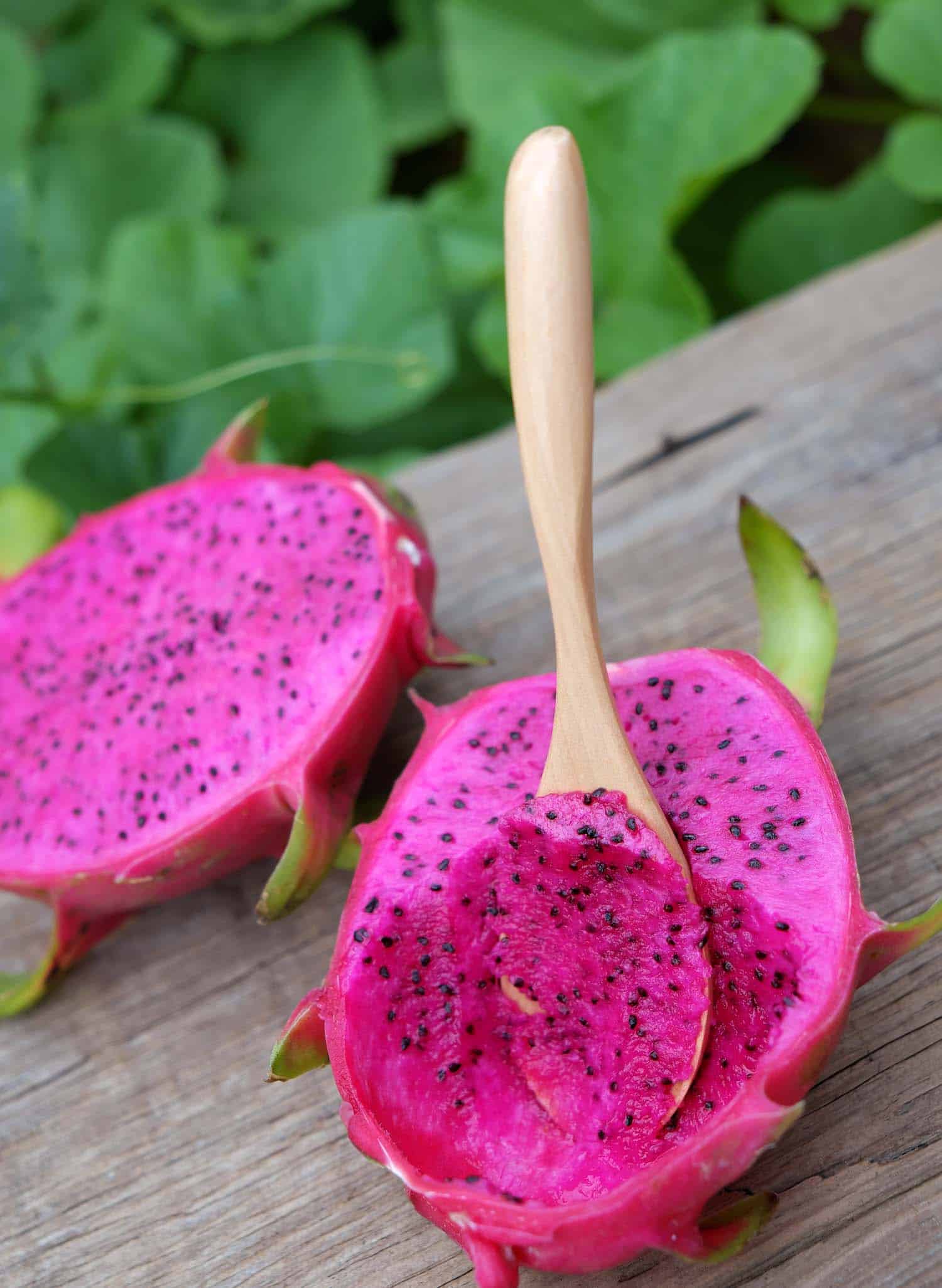
Pitahaya
Also known as dragon fruit or pitaya, I have to admit it’s not one of my favourite Peruvian fruits.
And that’s because while it is beautiful, it doesn’t have the same vibrant flavour as other Peru fruit.
Pitahaya is a cactus fruit and comes in many different colours:
- Pink skin with pink flesh
- Pink skin with white flesh
- Yellow skin with white flesh (common fruits in Nicaragua)
Although it’s common to find the pink varieties around the world. The yellow skin pitahaya is from Latin America.
Dragon fruit has a very mild flavour that I think is best as a juice as it’s often the prettiest thing in a fruit salad but the last thing I want to eat.
Dragon Fruit Season in Peru
October to January
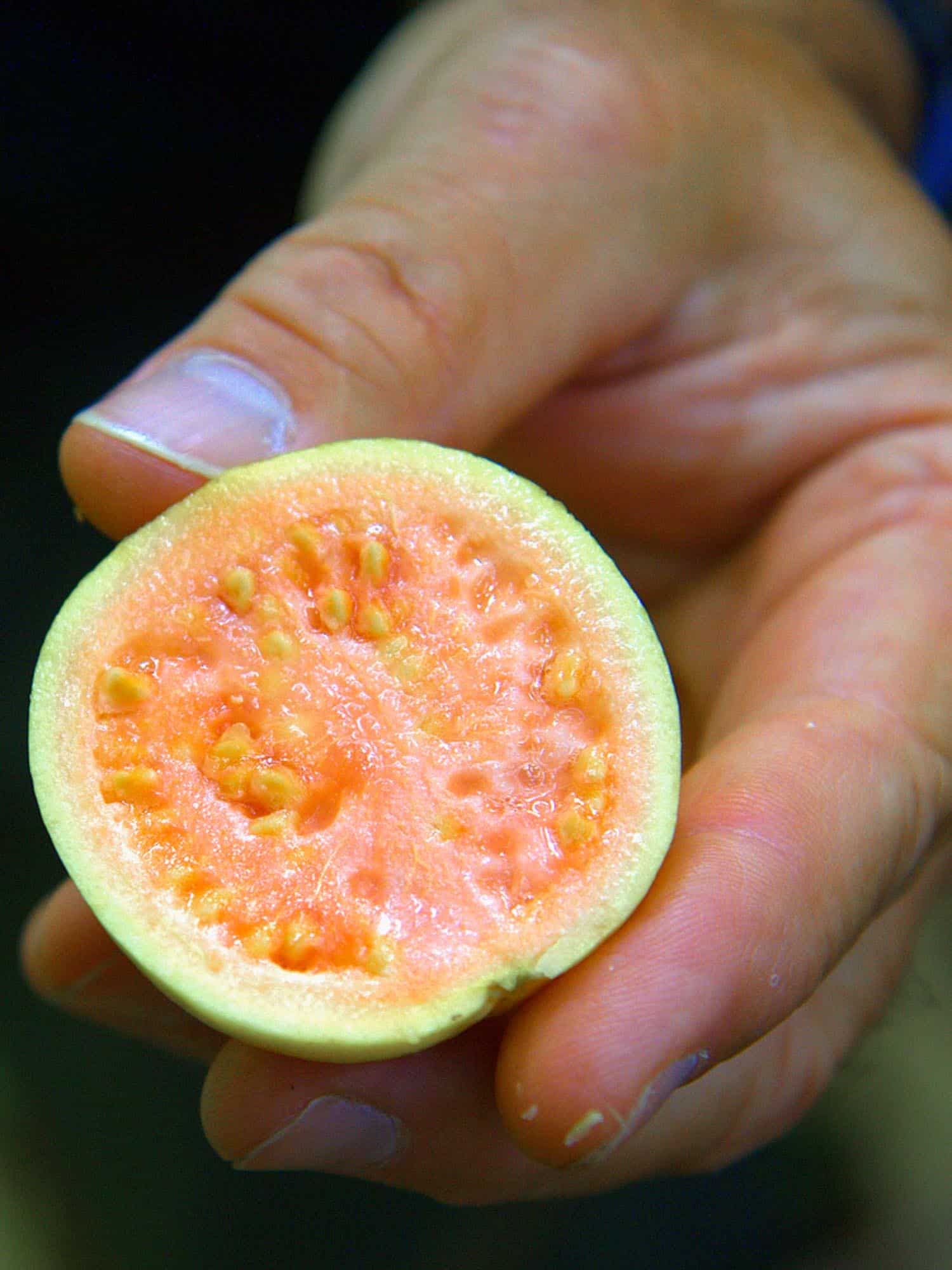
Guayaba
One of my absolute favourite fruits in Latin America. Guayaba, or guava as we know in English, are from Mexico.
Yet they traveled quickly through Central and South America as there is evidence they were eaten by pre-Inca people.
You can find them in various colours from yellow skin and white flesh, to the more common green skin pink flesh in Peru.
The Tastiest Mexican Fruit
Guavas are fantastic raw but it is very common to drink guava juice, or eat it in jams and desserts. The flavour is mild but refreshing, almost like a pear.
It’s why guava juice is so popular at breakfast, it’s a great way to start the day PLUS it also has four times the vitamin C as orange juice.
Fun Fact: In India the Hindi name for guava is Peru!
Guava Season in Peru
November to March
Camu Camu
Another miracle Peru fruit from the Amazon. It can be as large as a lemon and grows on bushes. Camu camu can provide up to 60 times more vitamin C than an orange, more than any fruit in the world.
It has a long list of healthy benefits. Although it’s naturally organic and non-GMO it’s not very expensive to buy Camu camu powder for smoothies
But to eat the fruit you need to travel to Peru. You may want to try it raw, but only try one. It’s very tart and almost as sour as a lime. And so it’s most common to eat this Peruvian fruit in juice or ice cream, jam and desserts.
Camu Camu Season in Peru
April to July
Tumbo
The maracuya or passionfruit family is so large that it’s almost difficult to keep track – especially when you ask locals what a Peru fruit is and they simply say maracuya!
Although they all look different they all have a similar inside. Many people don’t like to eat maracuya raw because they have a vicious inside with edible seeds that some people equate to snot.
Personally I like to add it to a bit of yogurt and you get all the favour without the snot texture.
Tumbo grows in the Andean valley and is known in English as banana passionfruit because of its shape. It is also known as curuba, parcha and taxo in other regions.
Tumbo is a bit more acidic than other maracuya and many people think they are too tart to eat on their own.
You’ll most often find tumbo in juice, smoothies, ice cream and jam.
Tumbo Season in Peru
June through September
Mango
You’ve probably had a Peruvian mango in the past. It is one of the biggest Peru fruit exports. In fact this tropical fruit is often sold frozen so we can make smoothies at home.
But there’s nothing like eating one that was ripened on the tree and served fresh.
But mango is not native to Peru. In fact it’s from India and is a common Vietnam fruit but the Spanish conquistadors brought it with them and it flourished in Peru.
Mangos are a very cheap fruit in Peru and so you’ll find a lot of ice cream, juices and smoothies with mango. The most typical variety has a reddish skin and flesh that is more orange than yellow.
Mango Season in Peru
December to March
Guanabana
Although you can find this Peruvian fruit around the world, it actually originated in the rainforest in Peru.
More commonly known in English in as soursop, it has all the complex flavours you expect from fruit here. Some say it tastes like pineapple and strawberry, others can taste pear and kiwi.
Like most fruits from the Amazon, it has quite a number of health benefits and many believe it can go as far as curing cancer.
It is a giant fruit that can weigh 5lbs or more. And so in markets you’ll often see it cut into chunks.
It’s rarely eaten straight as a fruit but you can pull the pulp almost like string cheese.
But NEVER eat the seeds as they are toxic. Instead blend them and use them as a natural insect repellant.
It is very commonly consumed as guanabana juice, smoothies and ice cream. But be careful not to drink too much juice as it is a diuretic.
Guanabana Season in Peru
All Year Round!
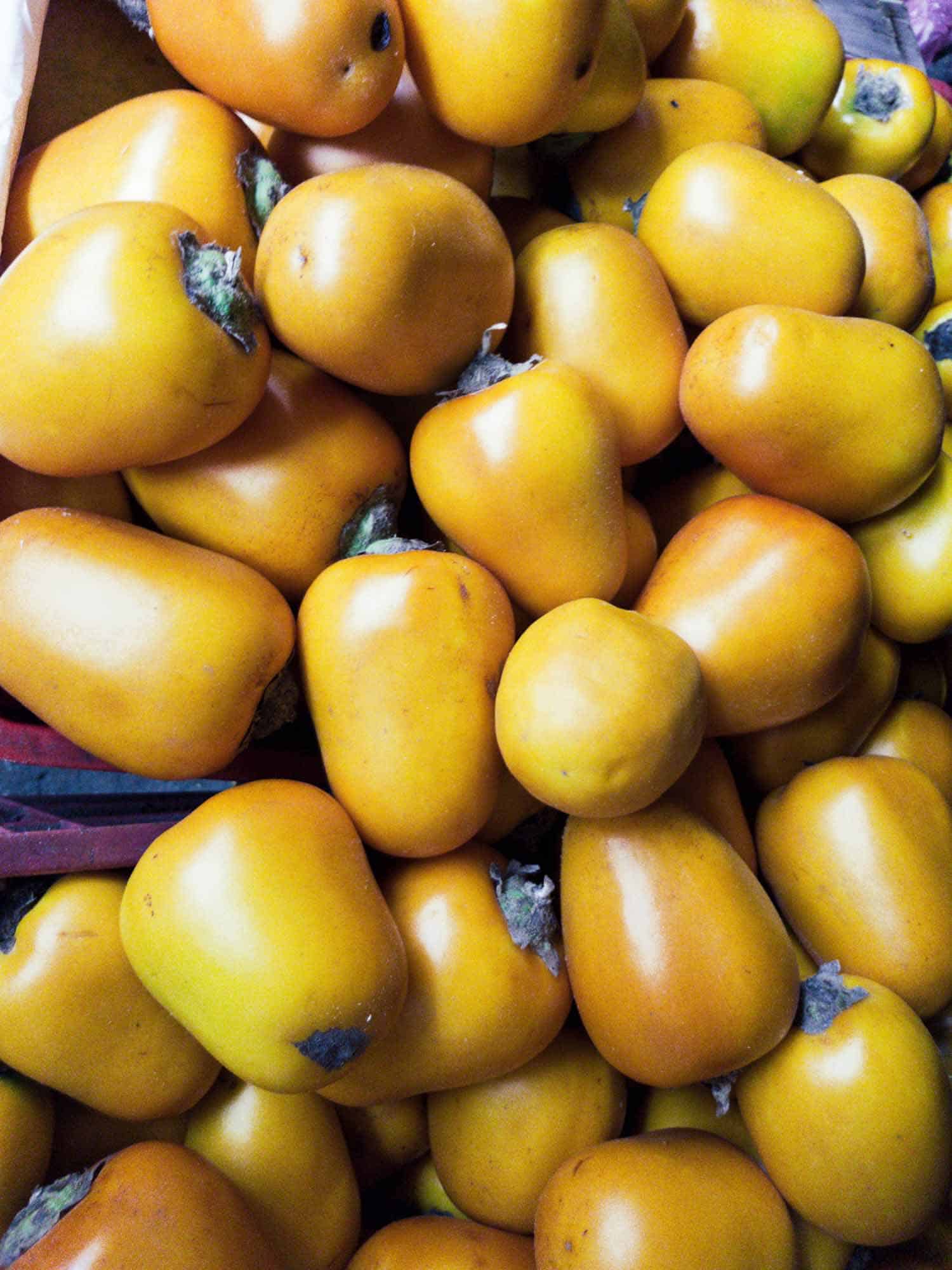
Cocona
Known as the Amazon tomato or peach tomato and is a nightshade fruit related to the tomato and eggplant.
You also can find this Peruvian fruit in Brazil (known as Cubiyú) and Venezuela as the topiro, topiru or Orinco apple as it’s found near the Orinco river.
It’s not common everywhere in Peru. You’re more likely to see it in Cuzco but it could be very difficult to find in Lima.
It’s a tropical citrus that is used so many savoury and sweet ways from juice and desserts to hot sauce (known as ají de cocona or cocona uchu) and even as a condiment for empanadas.
Granadilla
From the passionfruit family, granadilla is often confusingly just called maracuya. In English it is differentiated by being called sweet passionfruit.
It is the sweetest variety and is not nearly as acidic as others.
Also known as the sweet passionfruit, this tasty Andean fruit is similar to its more famous cousin, but with a sweeter, less acidic flavor.
Well-known in Peru for its positive effects on the digestive system, the granadilla is a great source of fiber, calcium and several essential vitamins.
Sweet Passionfruit Season in Peru
All Year Round!
Maracuyá
This original maracuyá (passiflora edulis) or passionfruit. It is known all over the world and sometimes called lulo in South America or lilikoi in Hawaii.
It is a bit more sour than granadilla and so it’s rarely eaten raw. Instead it’s common in juice, alcohol drinks, ice creams, smoothies and desserts.
Passionfruit Season in Peru
May to October
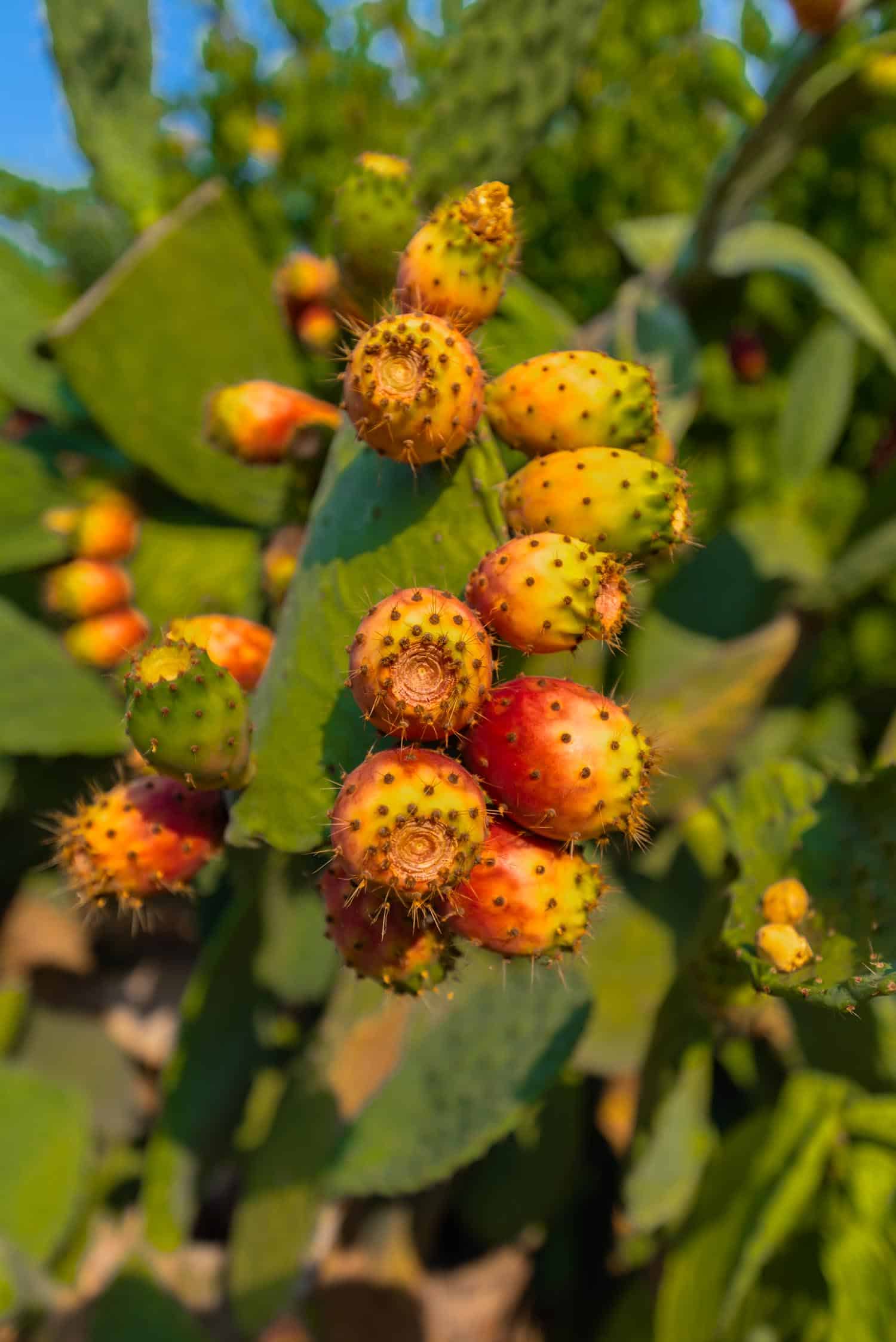
Tuna
Not to be confused with the can of fish called atún, this is one of my favourite Peruvian fruits.
I first discovered it when I mistakenly thought I could hike Colca Canyon. I made it all the way down to the bottom but I had no desire to go back up to the top.
And so I took a mule to the top and I don’t regret it at all!
I had to wait for the mule and so some locals showed me this prickly pear that grows on paddle cactus (aka Mexican nopal) in Peru.
You can find it throughout arid places in Latin America where cacti grow. It looks like an oval the size of a pear but the skin is thicker and ranges from yellow/green to orange red.
Don’t eat the skin but you can definitely eat the seeds.
Inside it is bright pink or red and is so sweet. It has a berry-like flavour but also the sweetness of figs.
It’s common to find it as a juice but I prefer to eat it as a fruit. Just cut off the ends and peel the fruit. It’s delicious!
Pacay
So pacay was explained to me as both a legume and a fruit. I don’t know if that’s possible but if you know the answer leave a comment below.
This Peru fruit is native to the Andes and common in Cusco. But also you can now find it throughout Latin America, often around coffee plantations.
Pacay is known as guaba in Costa Rica and in English we call it the ice cream bean.
27 Costa Rican Fruit You’ll Adore
It’s called that for obvious reasons. It has the confectionary flavour of vanilla ice cream and sometimes like cream soda or cotton candy.
You open the pod and basically suck the sweet flesh off the seeds. They say it’s good for digestion and stomach ailments.
Pacay Season in Peru
August through January
Pepino Dulce
It doesn’t look like a cucumber and it’s actually a melon but pepino dulce means sweet cucumber.
And maybe that’s because it really does taste like a sweet cucumber, or a melon cucumber mix. It’s fresh but sweet.
It’s native to the highlands in Chile and Peru and has made its way through Latin America.
But it’s rare to see it exported or shipped far as it has such a thin skin. They also need to be eaten within a few days so they rarely go far.
Pepino Dulce Season in Peru
November to April
Papaya Arequipeña
Named after one of my favourite Peruvian cities, Arequipa, I can’t stand papaya but I do like this one.
In general I find the texture of regular papaya too soft and the flavour borderlines on stinky socks…and not the good like of stink of blue cheese. More of the flavour that I worry I’m eating a rotten fruit.
Papaya arequipeña is found in southern Peru and is quite sour. It’s not a Peruvian fruit to eat in a salad and instead one for juice or dessert.
I actually like the sourness of it and try not to have too much sugar in my drink.
There’s not a lot of information about “aapaya arequipeña” Locals told me it’s sometimes called papayuela. This was a huge discovery as I found lots of information on its English name – mountain papaya or mountain paw paw.
The most interesting thing about mountain papaya is that the fruit don’t grow on branches, instead they grow up the trunk, completely covering it.
I tried to find a tree but I could not.
Noni
Noni is a bit of a controversial Peruvian fruit but I absolutely love it.
It’s originally from Asia but you can also find it in Costa Rica. And the first time I had it was in Hawaii and I am so thankful.
Most people in North America (outside Hawaii) probably haven’t heard of it. But it’s incredibly good for you and people have been drinking noni juice for thousands of years.
It’s most commonly known as the Indian mulberry, great morinda and sometimes the beach mulberry.
It hasn’t become an international fruit star because of its smell…some people call it cheese fruit because it has a strong parmesan cheese like smell. But others call it vomit fruit because they can’t stand the smell.
Personally I don’t mind it. I like things that smell and taste like parmesan. I mean anything is better than the durian fruit.
It can be eaten raw and many people have begrudgingly eaten it when there was nothing else to eat. It is very bitter and so it’s not appetizing. For this reason it’s been called the starvation fruit.
But noni is delicious when made into a juice with other fruit, or cooked in a stew.
Noni is a superstar in natural medicine and around the world it is used to cure everything from impotence to asthma.
Although it’s best to eat it fresh there is a huge market for noni fruit powder and pill capsules.
Noni Season in Peru
June to September
Saúco
Small like grapes and growing in bunches, sauco is better known as elderberry.
Not all elderberry can be eaten raw but saúco is the sambucus species that the Spanish conquistadors brought with them.
Most often you’ll find saúco in markets sold as raw fruit. But you can also find it as a full fruit compote.
And if you look around hard enough you can find a saúco wine.
Pin it For Later: Peruvian Fruits
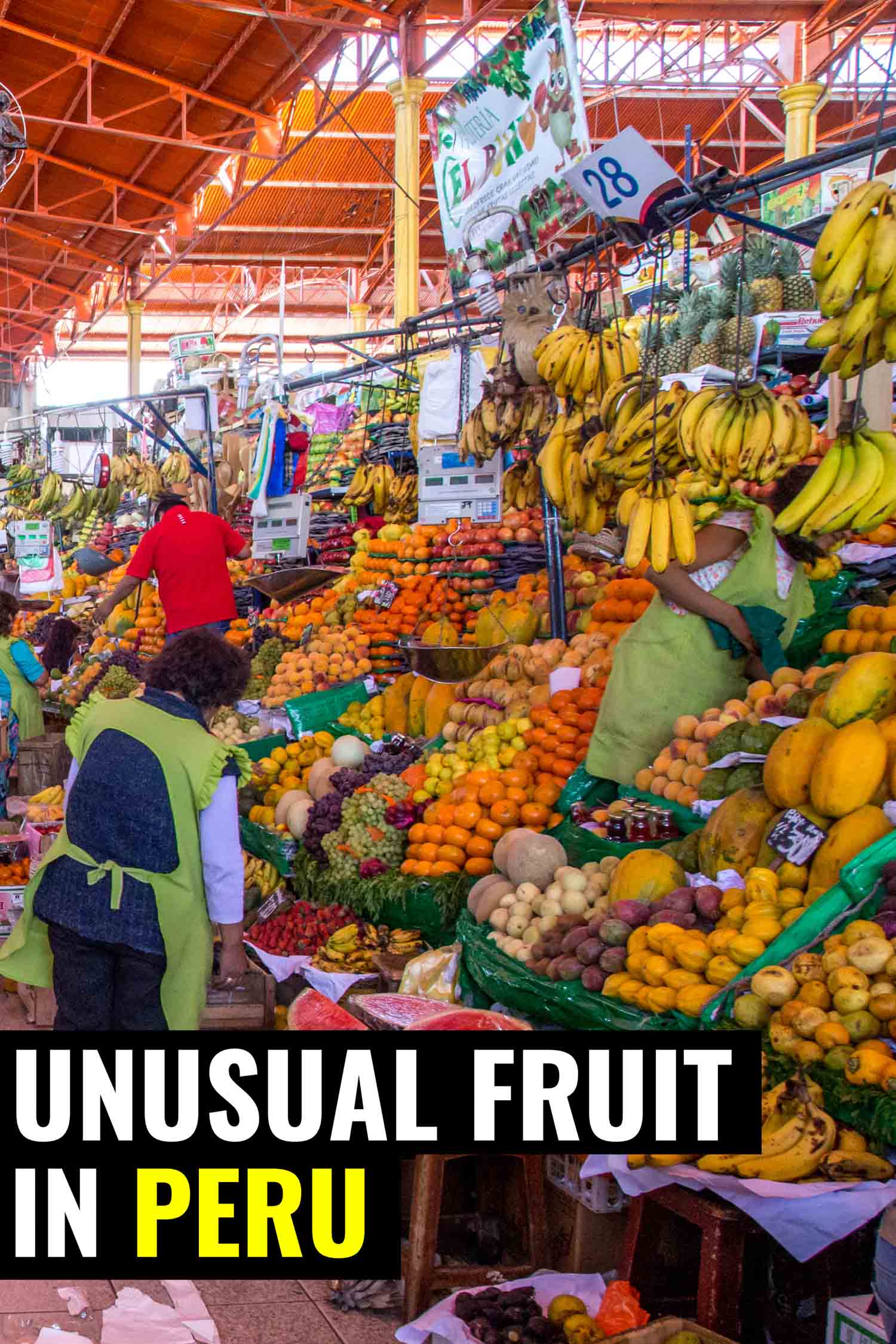
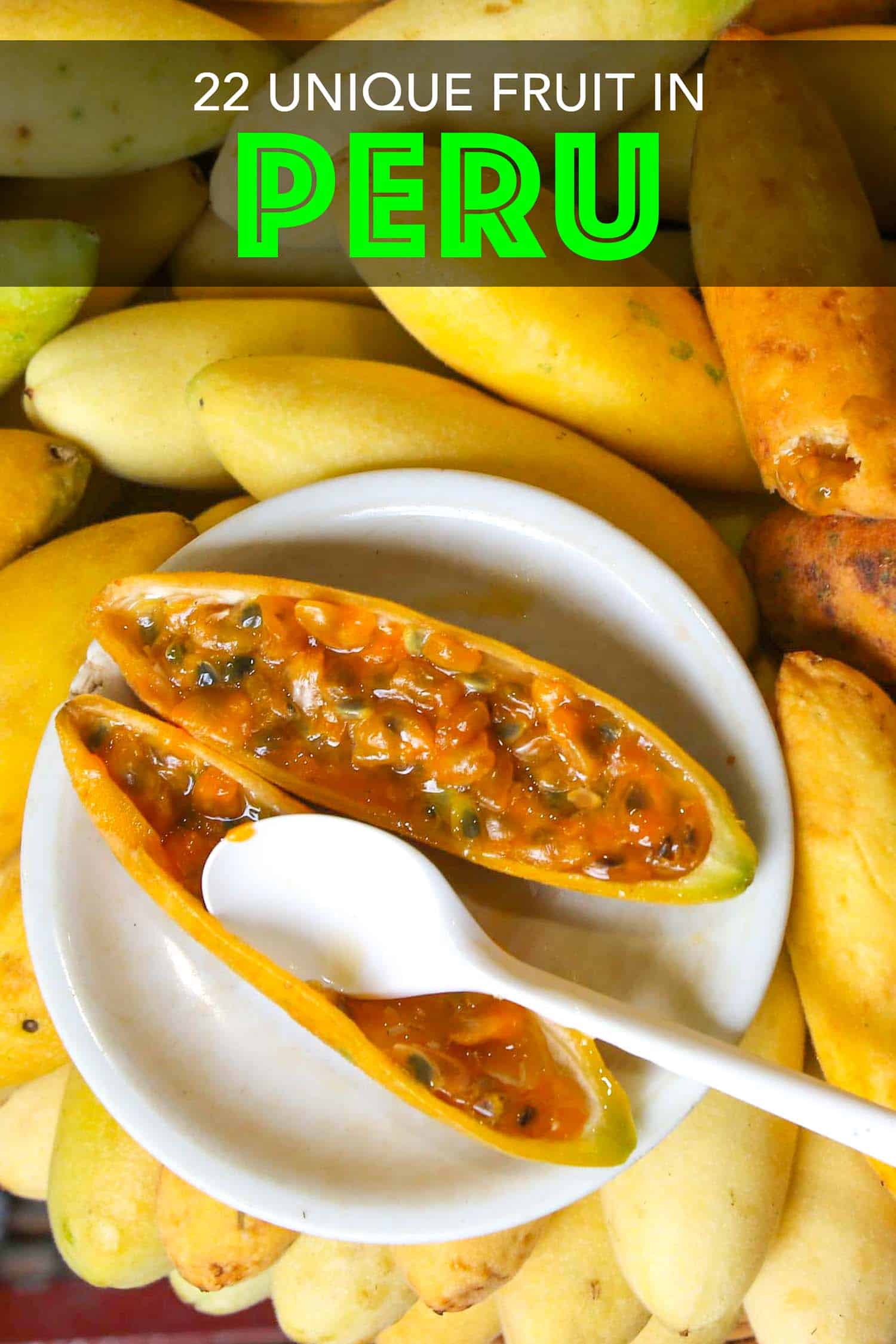
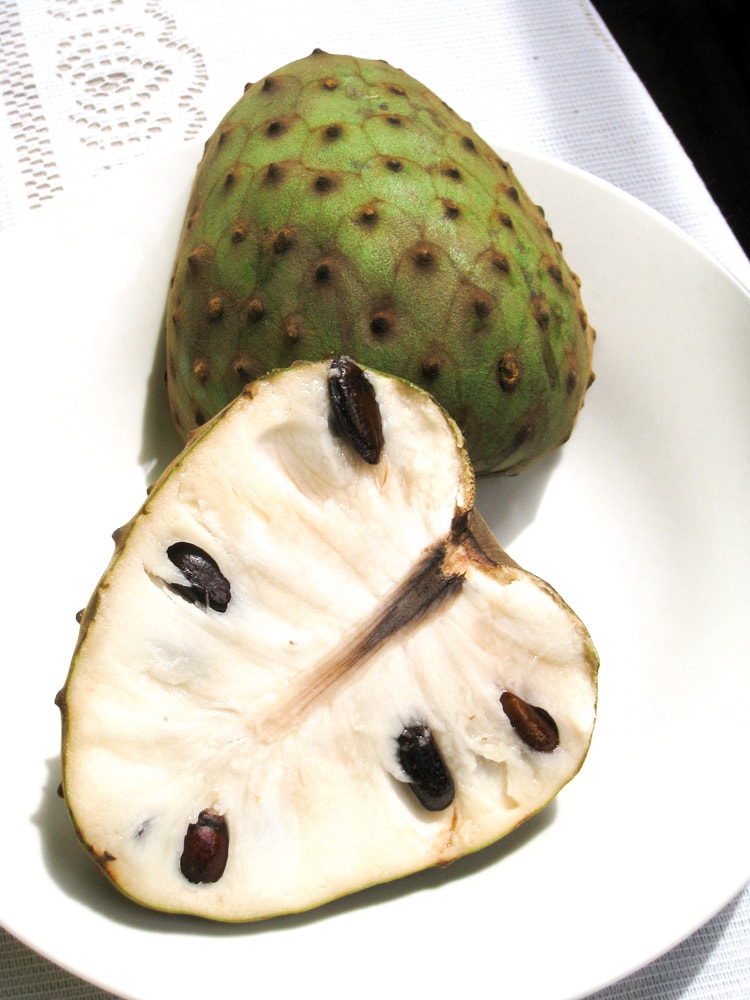
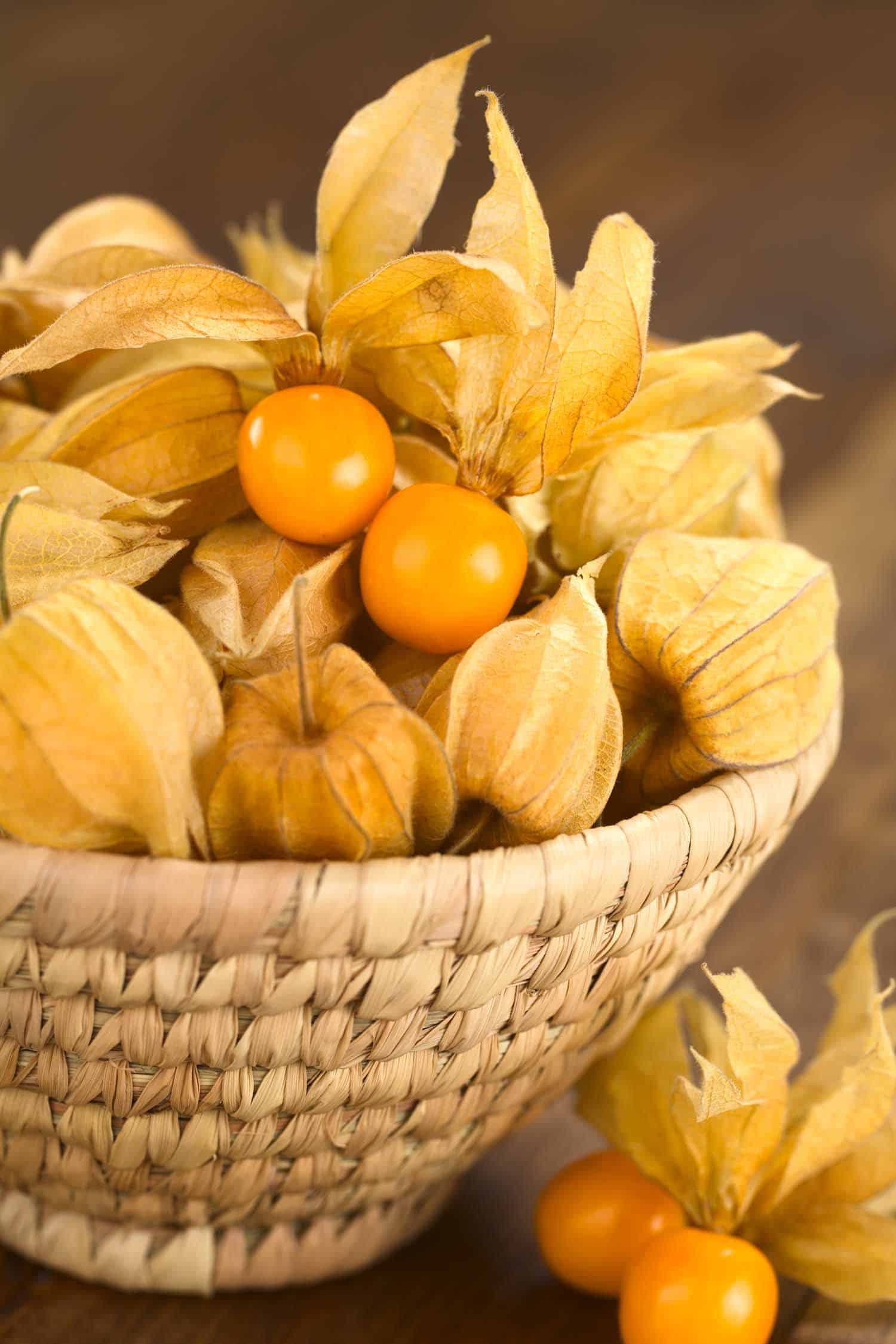

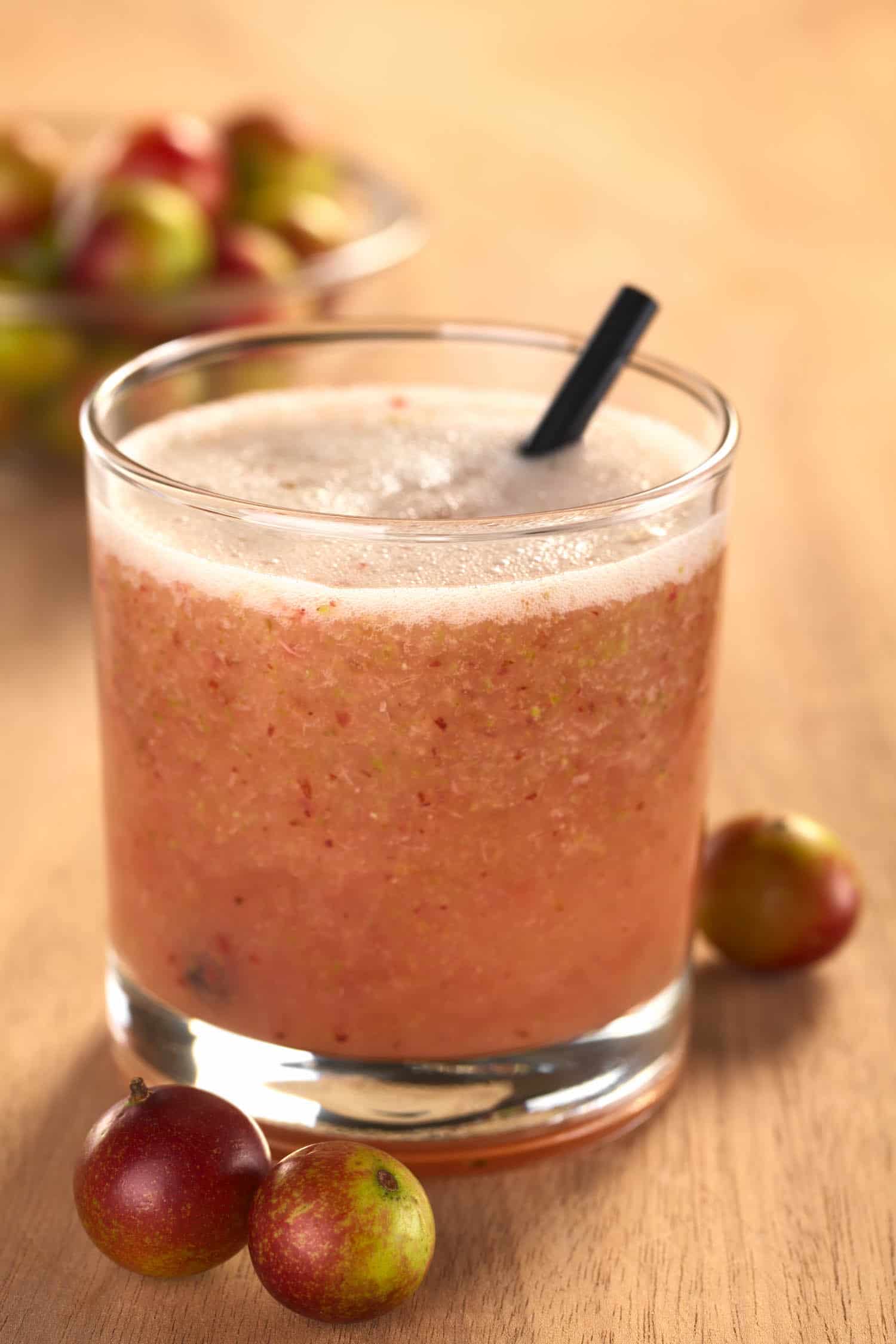
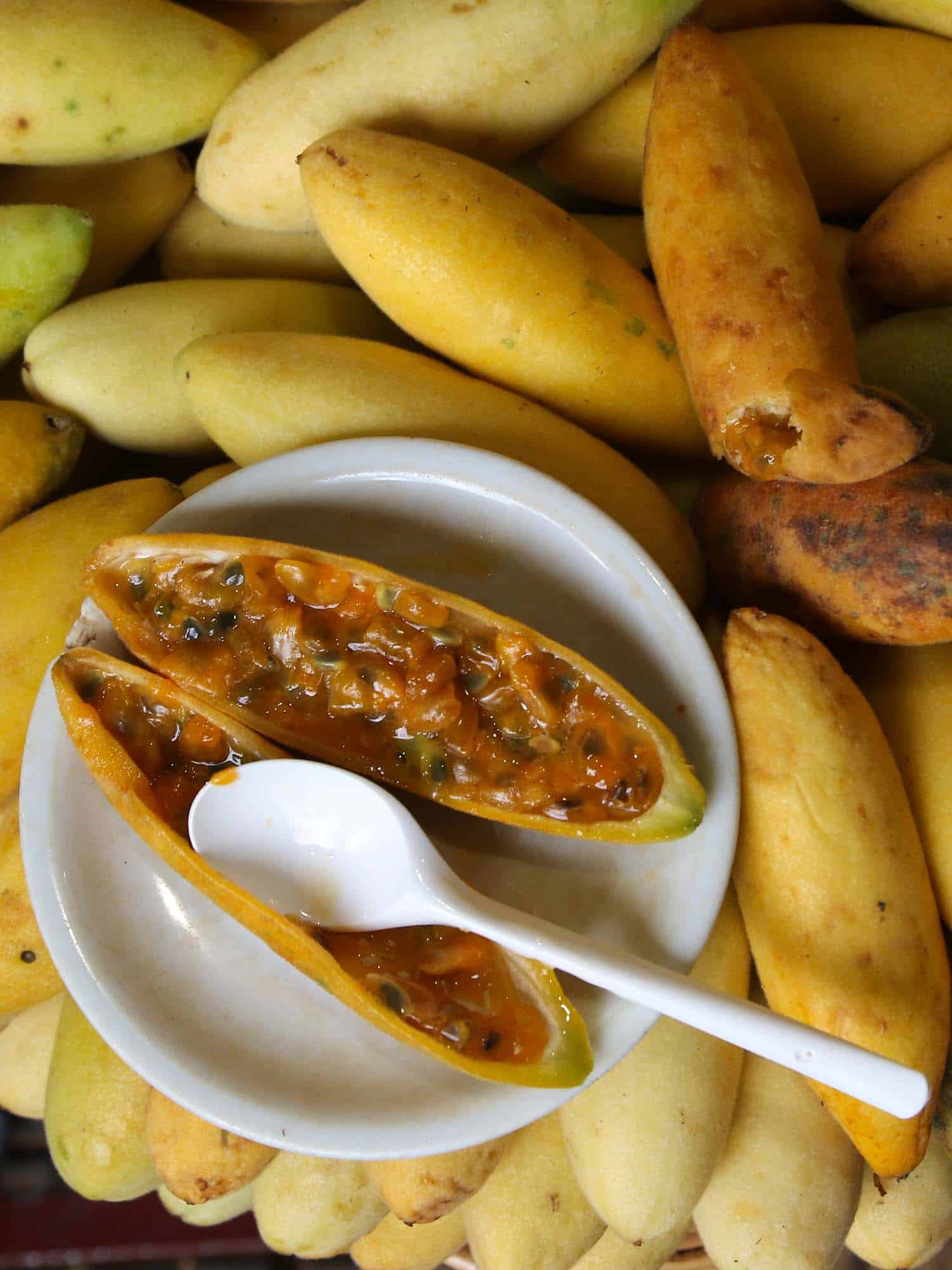
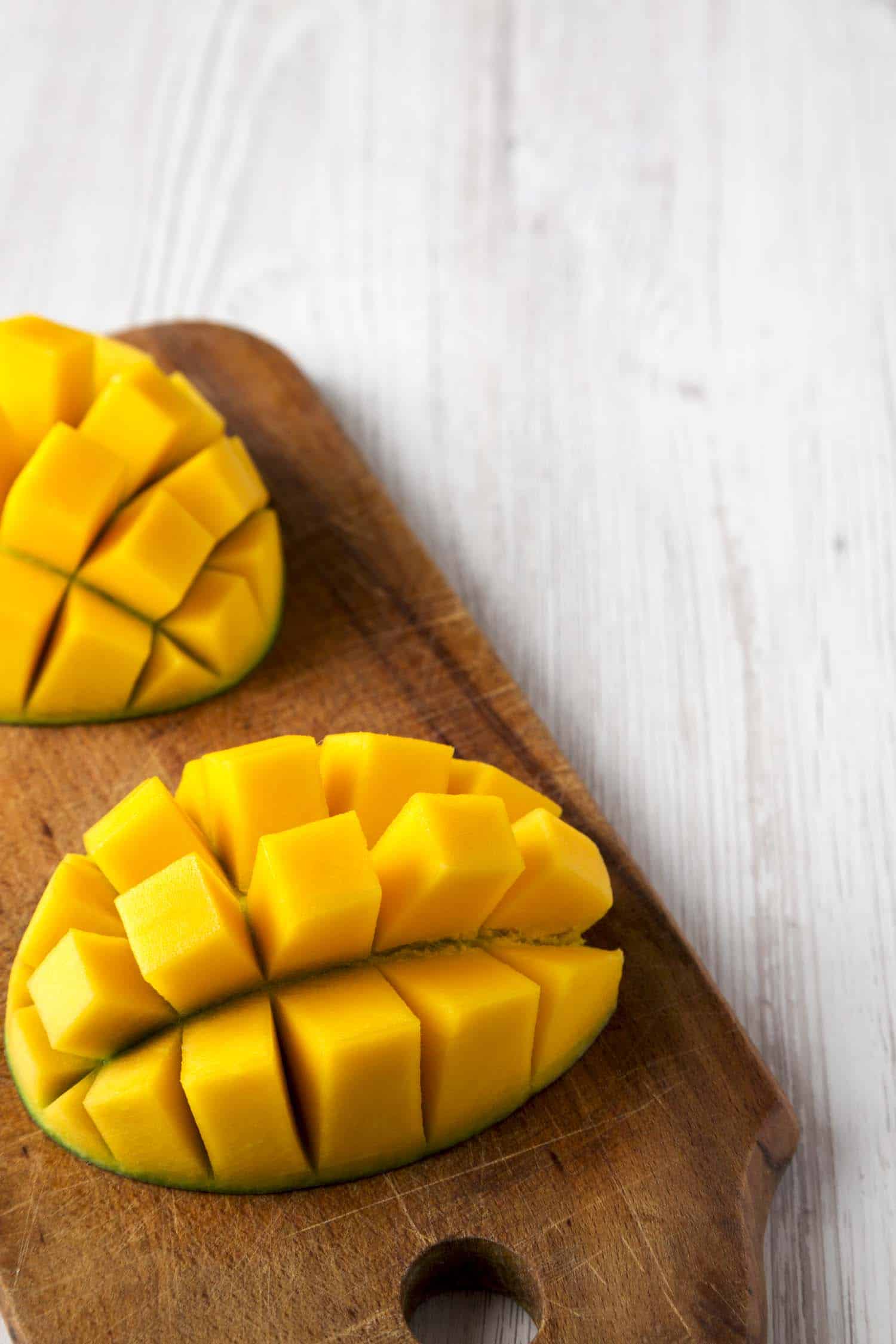
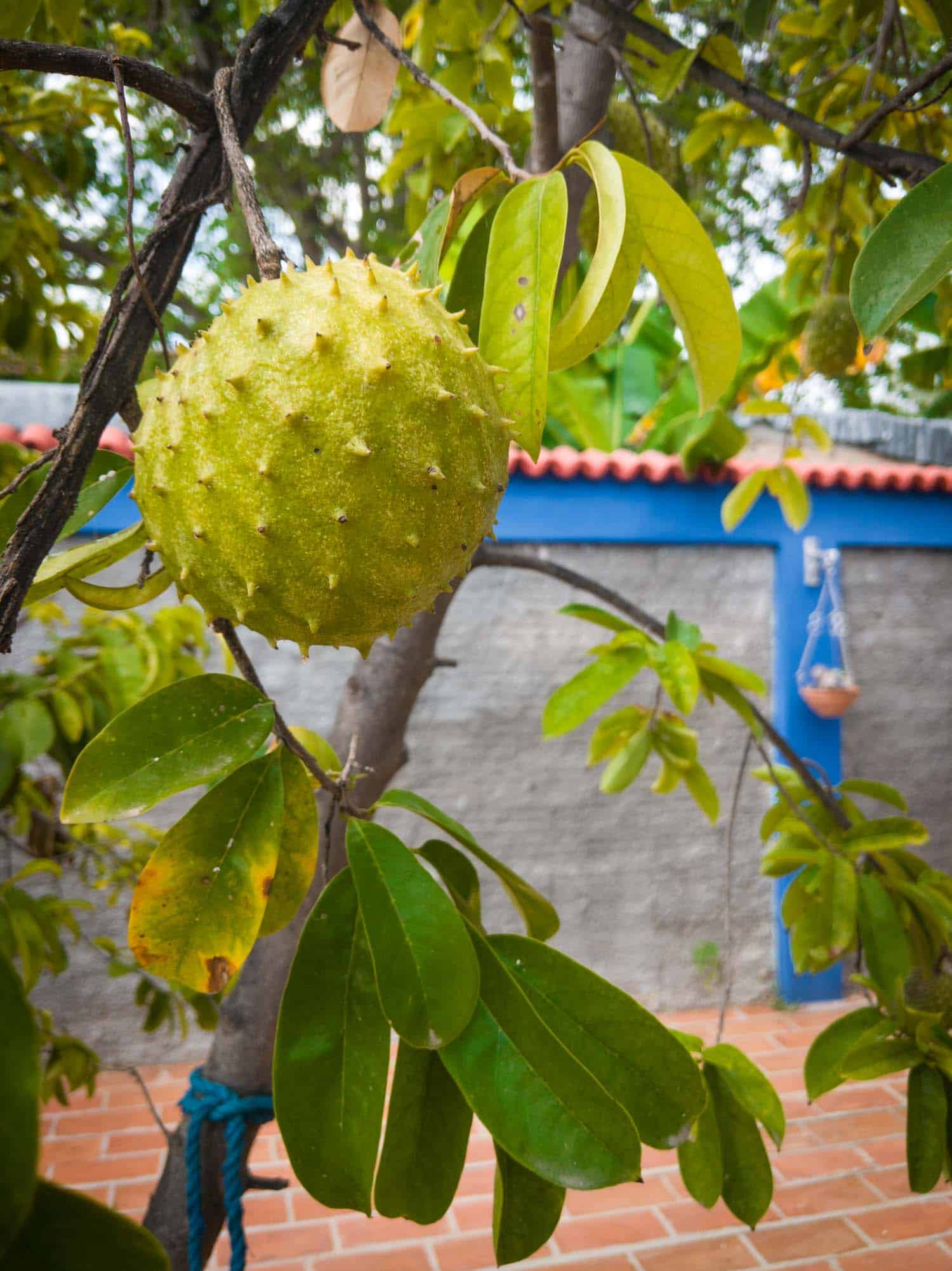
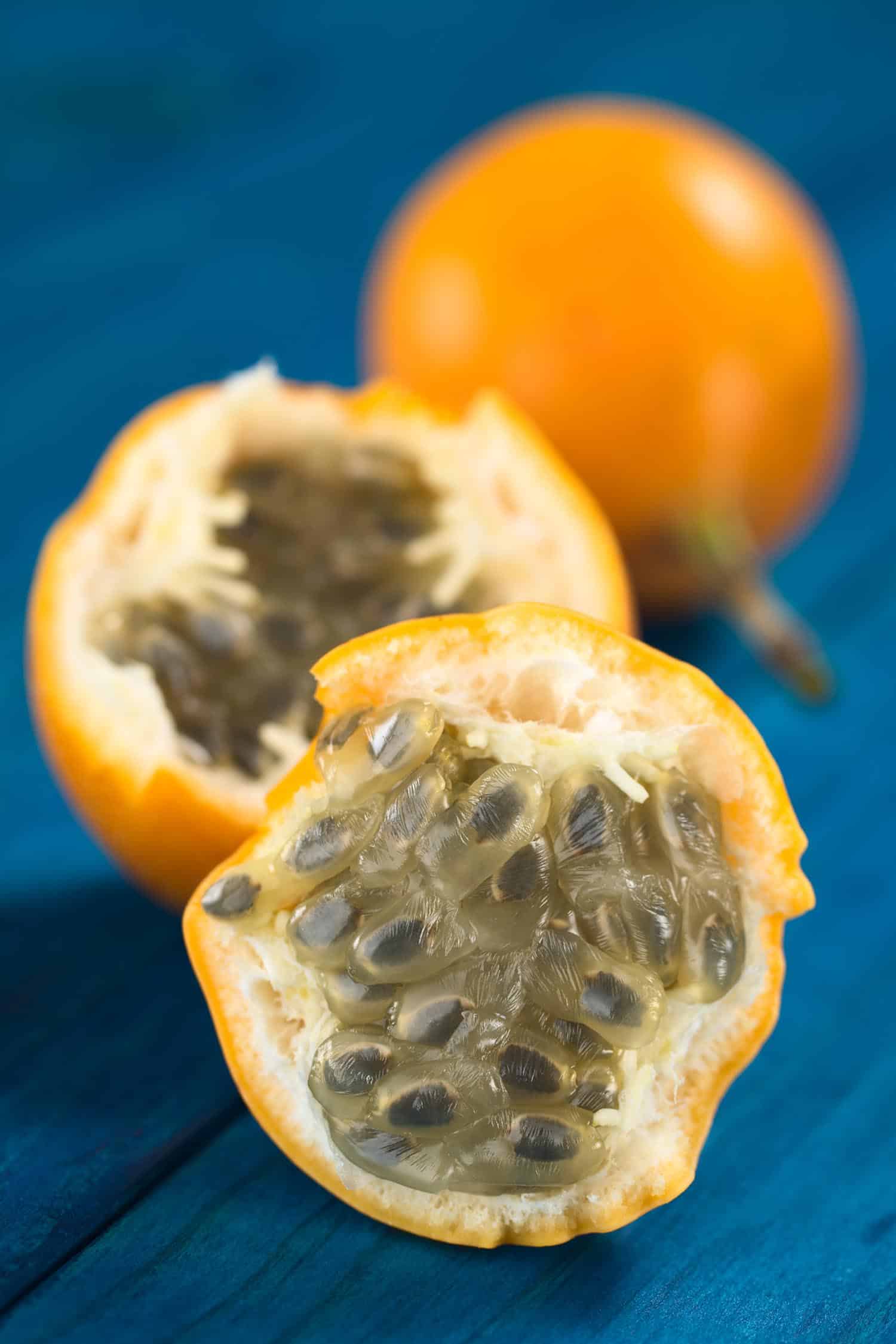
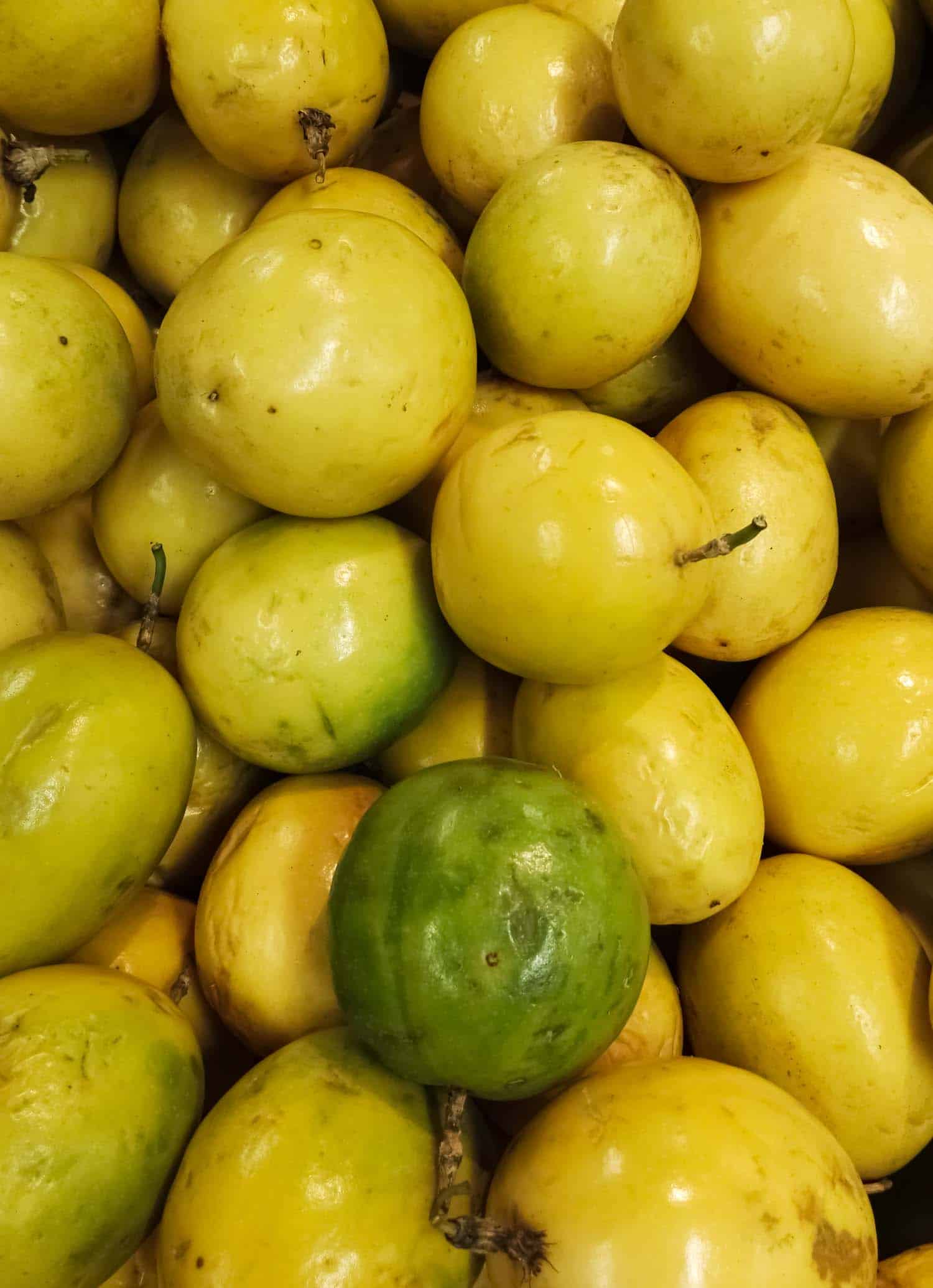
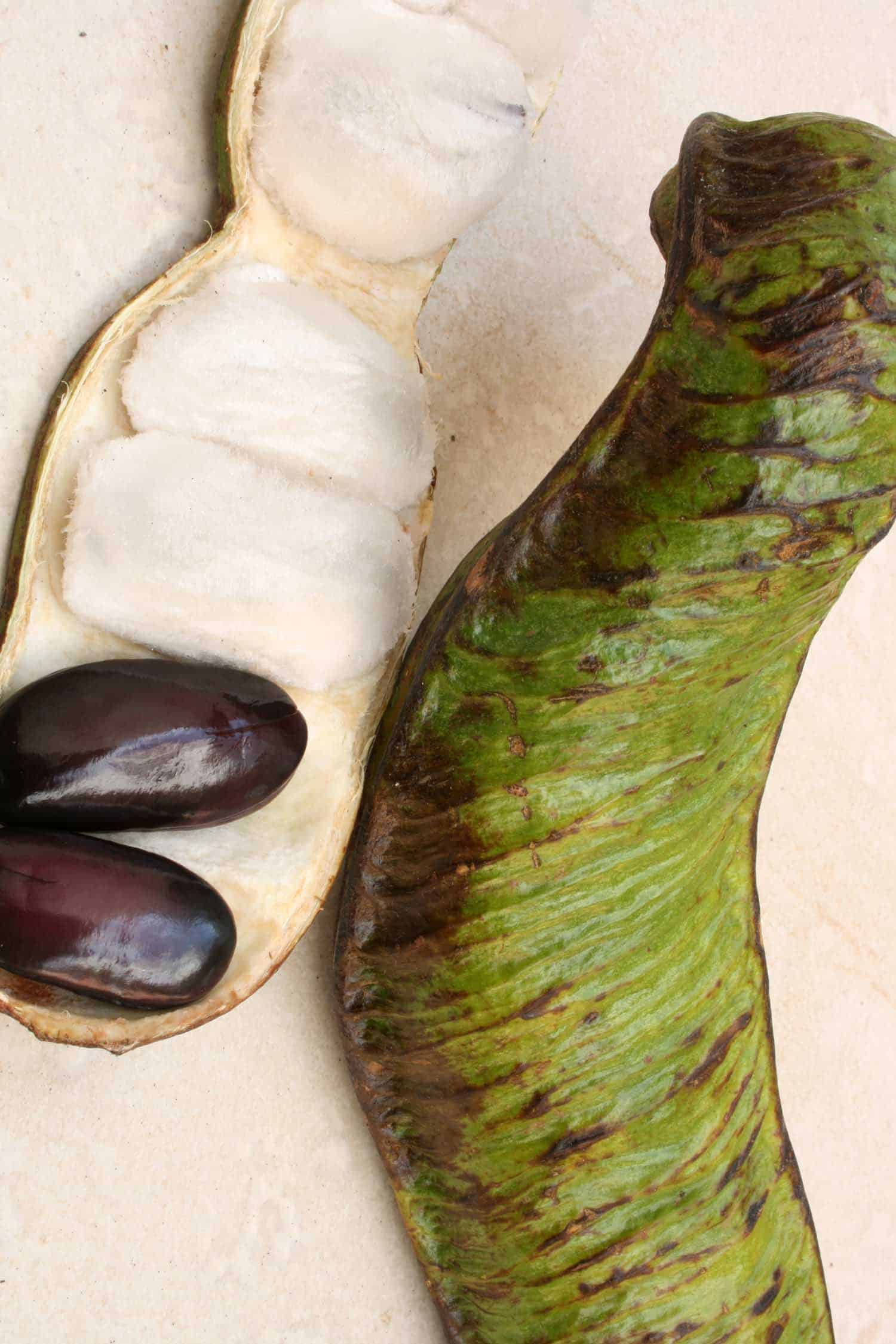
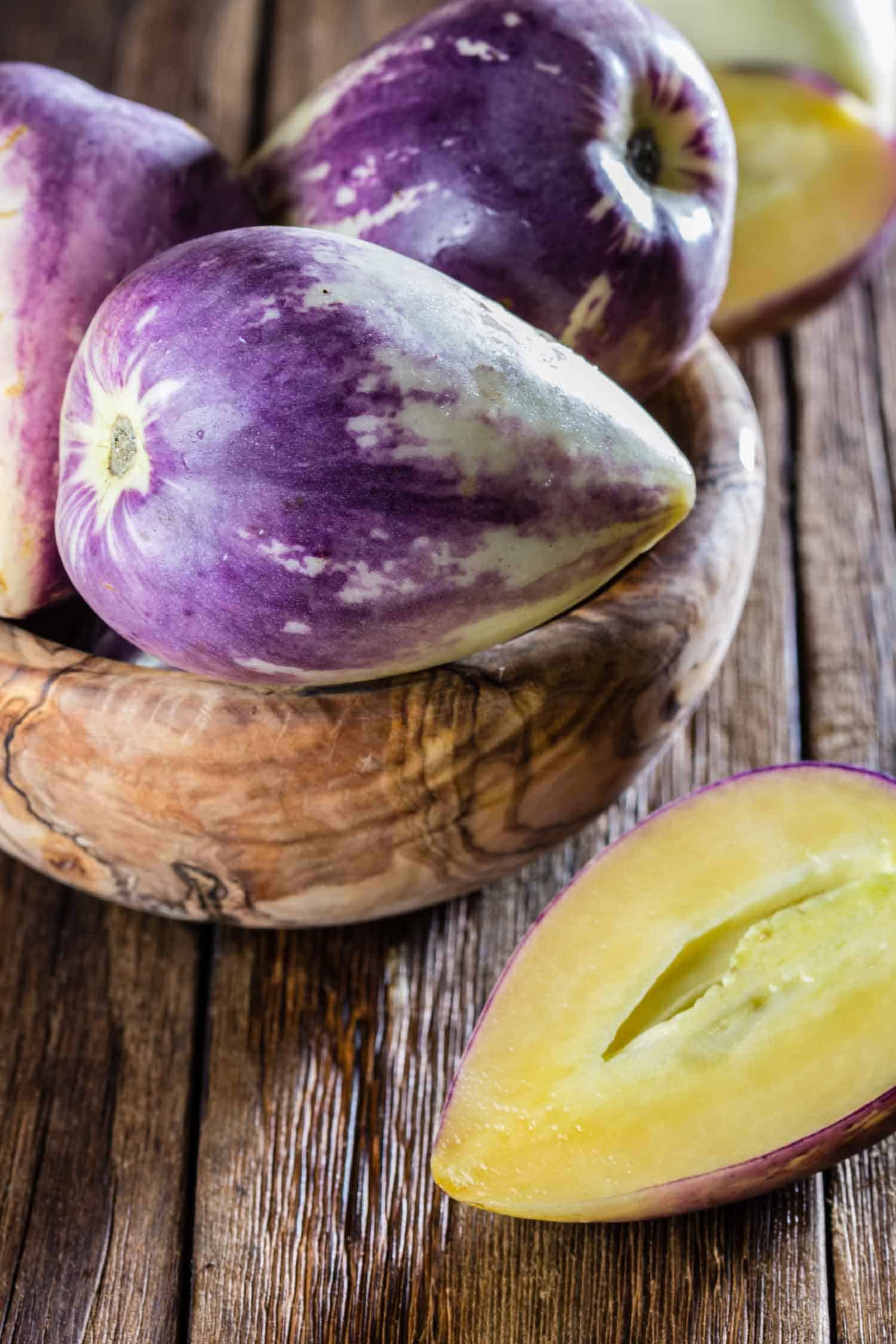
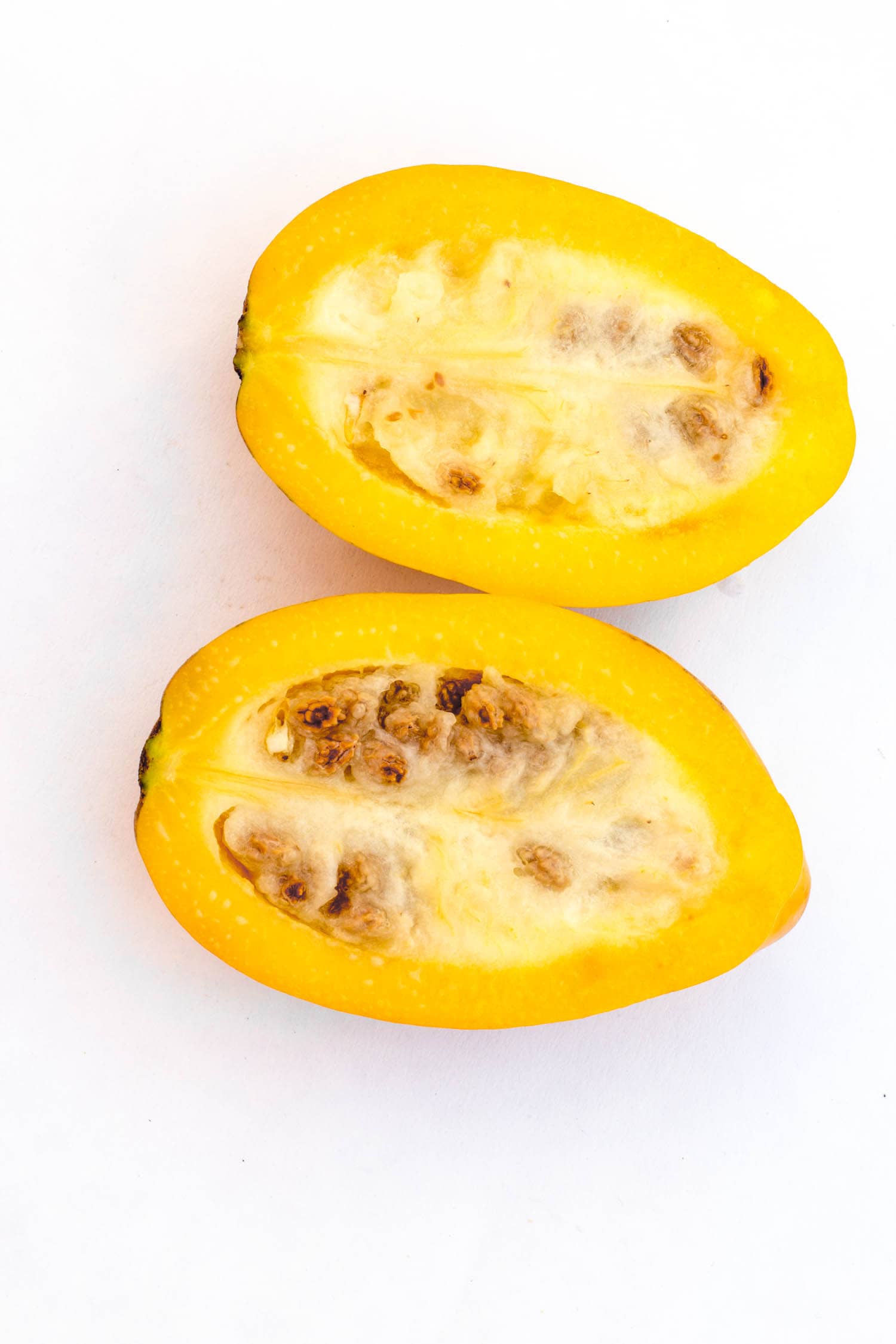
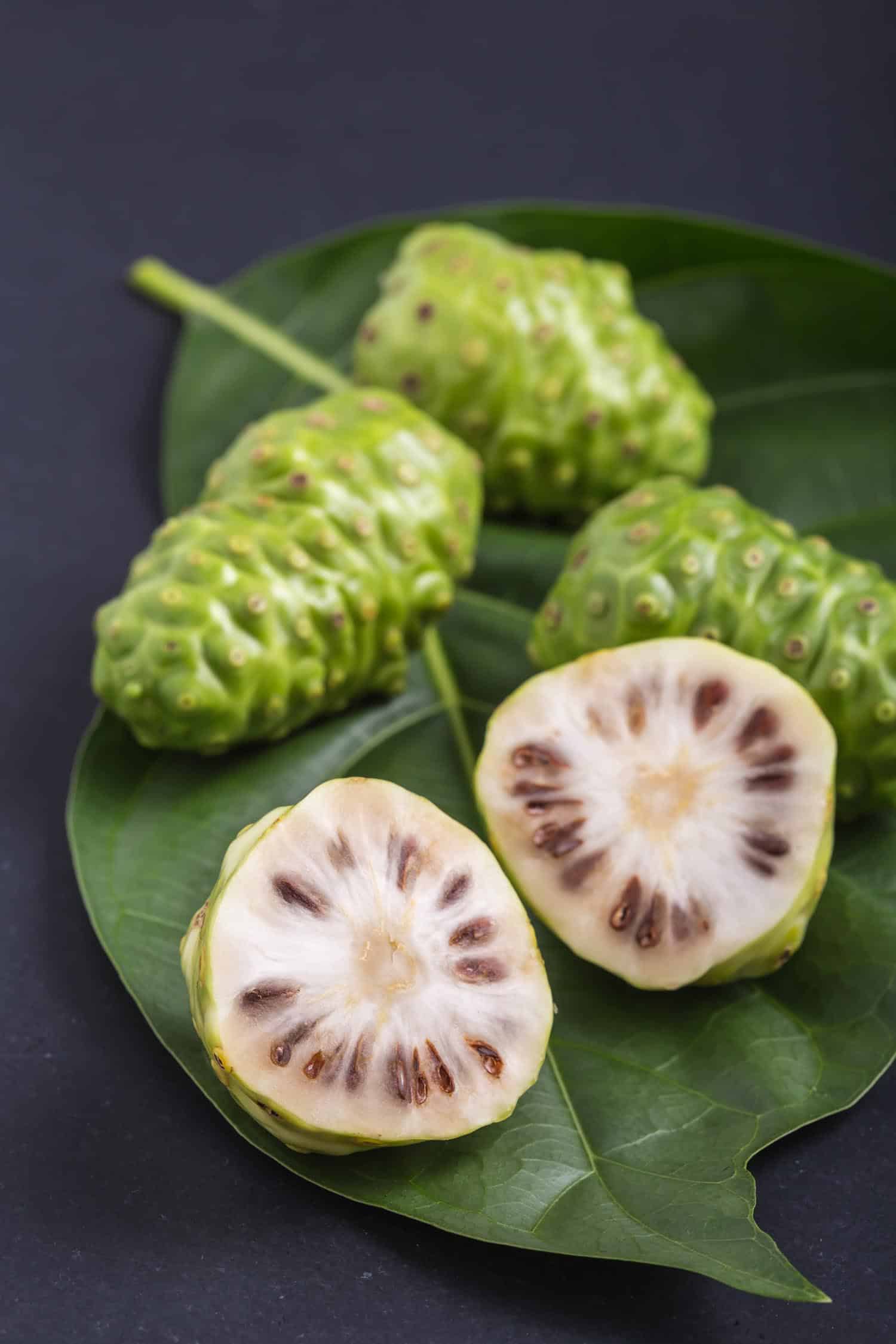
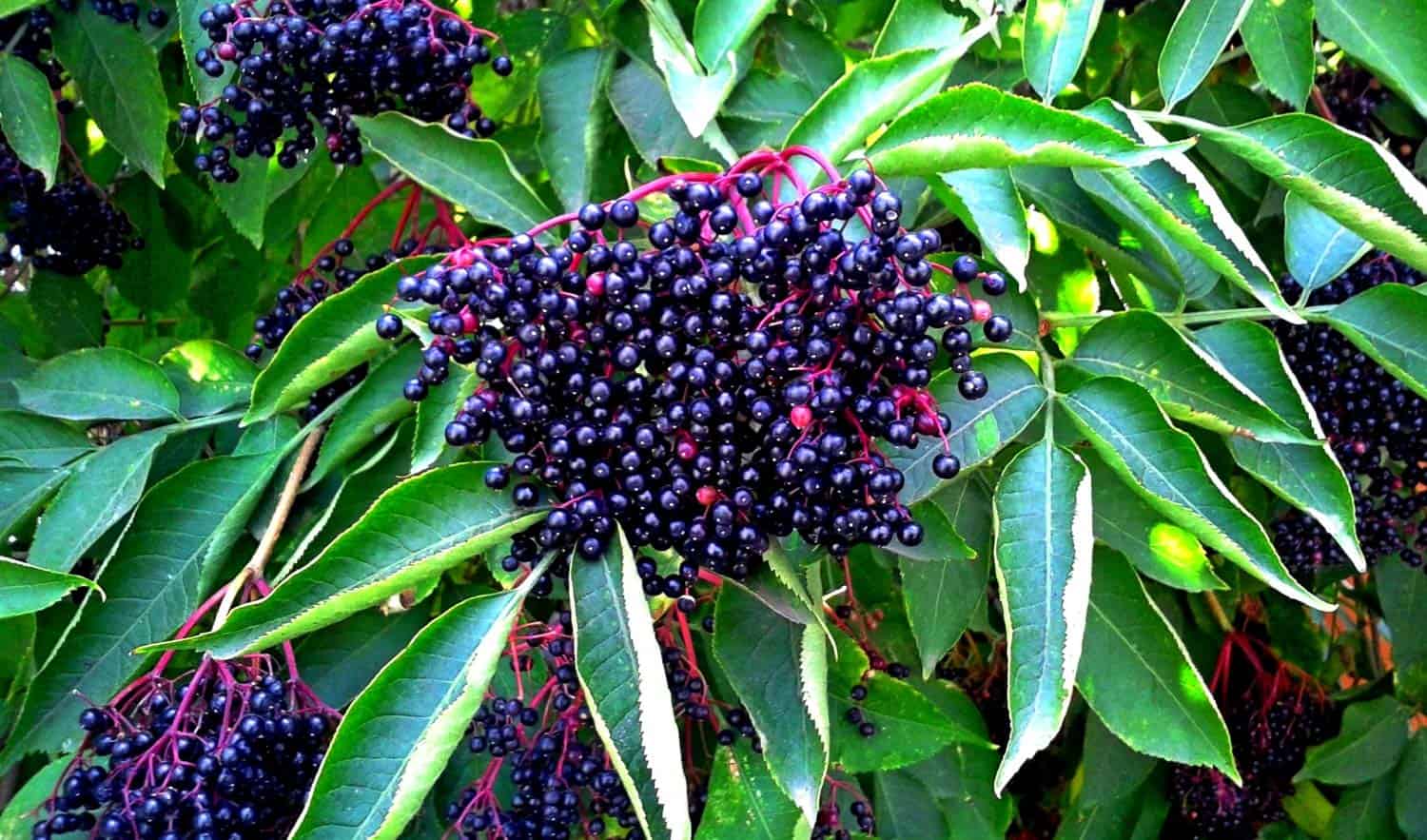
So interesting. I wrote a post about Fruits in Colombia and I did recognize some of these fruits but was new to others.
Guanabana is one of my favourites. You can find frozen pulp and popsicles here in London at the Latin Market.
I have a Colombian fruits post scheduled! I wonder how many of them are the same!